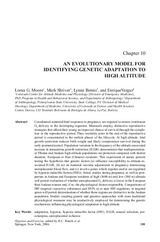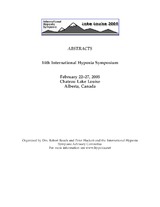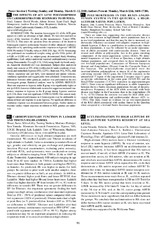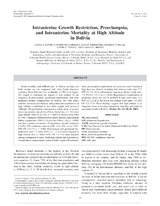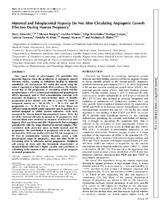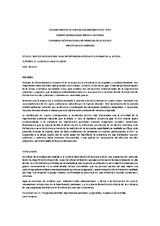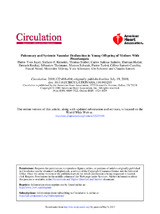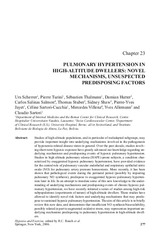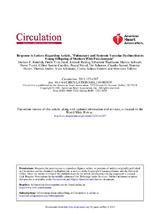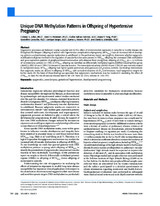ListarProducción científica por tema "PREECLAMPSIA"
Mostrando ítems 1-12 de 12
-
An evolutionary model for identifying genetic adaptation to high altitude
(Adv Exp Med Biol., 2006)Abstract Coordinated maternal/fetal responses to pregnancy are required to ensure continuous O2 delivery to the developing organism. Mammals employ distinctive reproductive strategies that afford their young an improved ... -
Does chronic mountain sickness (CMS) have perinatal origins?
(Respiratory Physiology & Neurobiology, 2007-06-29)Abstract. Chronic mountain sickness (CMS) occurs in 10% of male high-altitude residents. It is characterized by hypoventilation and hypoxemia but its underlying cause remains unknown. We hypothesized that CMS' origins ... -
High-altitude ancestry protects against IUGR and reductions in birth weight associated with high altitude and preeclampsia
(High Altitude Medicine & Biology, 2005-02-22)Background. Observations consistently demonstrate diminished birth weight [BW] with ascending altitude; however population comparisons reveal the extent of BW reduction depends, in part, upon high-altitude ancestry. ... -
Increased incidence of preeclampsia lowers birth weight and increases intrauterine mortality at high altitude
(High Altitude Medicine & Biology, 2001) -
Intrauterine growth restriction, preeclampsia, and intrauterine mortality at high altitude in Bolivia
(PEDIATRIC RESEARCH, 2003-02-18)Abstract. Infant mortality and stillbirth rates in Bolivia are high and birth weights are low compared with other South American countries. Most Bolivians live at altitudes of 2500 m or higher. We sought to determine the ... -
Maternal and fetoplacental hypoxia do not alter circulating angiogenec growth effectors during human pregnancy
(Biol Reprod., 2014-02-27)Abstract. One causal model of preeclampsia (PE) postulates that placental hypoxia alters the production of angiogenic growth effectors (AGEs), causing an imbalance leading to maternal endothelial cell dysfunction. We ... -
Nuevos mecanismos para hipertensión arterial pulmonar en la altura
(COLEGIO MEDICO DE BOLIVIA, 2016-02)RESUMEN. Durante la última década el alcance de la investigación en la altura se ha ampliado considerablemente. Dos importantes observaciones han generado este avance; Primero, el hecho de que el edema pulmonar agudo de ... -
Offspring of preeclamptic mothers are predisposed to hypoxic pulmonary hypertension
(High Altitude Medicine & Biology, 2005-02-22)Adverse events in utero may predispose to cardiovascular disease in adulthood. In preeclampsia, the diseased placenta releases circulating vasculotoxic factors that cause maternal endothelial dysfunction. These factors ... -
Pulmonary and systemic vascular dysfunction in young offspring of mothers with preeclampsia
(Circulation, 2010-07-19)Background—Adverse events in utero may predispose to cardiovascular disease in adulthood. The underlying mechanisms are unknown. During preeclampsia, vasculotoxic factors are released into the maternal circulation by the ... -
Pulmonary hypertension in high-altitude dwellers : novel mechanisms, unsuspected predisposing factors
(Adv Exp Med Biol., 2006)Abstract Studies of high-altitude populations, and in particular of maladapted subgroups, may provide important insight into underlying mechanisms involved in the pathogenesis of hypoxemia-related disease states in general. ... -
Response to letters regarding article, "Pulmonary and systemic vascular dysfunction in young offspring of mothers with preeclampsia"
(Circulation, 2011)We thank Lazdam et al and Yuan et al for their interesting comments on our study.1 Lazdam et al point out that in our study, birth weight in offspring of mothers with preeclampsia was significantly lower than in controls, ... -
Unique DNA methylation patterns in offspring of hypertensive pregnancy
(Clin Transl Sci., 2015)Abstract. Epigenomic processes are believed to play a pivotal role for the effect of environmental exposures in early life to modify disease risk throughout the lifespan. Offspring of women with hypertensive complications ...

